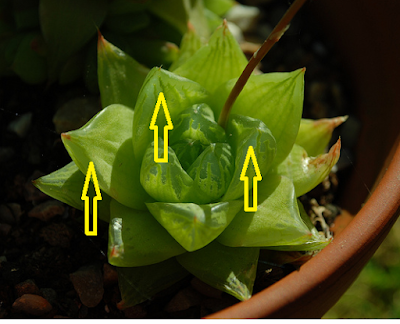 It’s a sunny Saturday morning, and one regular chore is
watering the house plants. The sunlight
was hitting a nice little Haworthia, a succulent member of the lily family
(although recent phylogenetic shakeups may have changed that), and the leaf
windows were pretty obvious. They tend to look darker green, but you're really looking down through the leaf tissue. Thick
leaves are good for conserving water, but their very thickness means light
penetration is limited. Having
transparent areas on the upper ends of their leaves not only allows light to
penetrate deep into the leaf, but it also allows a plant like this to grow almost
buried in soil. Keep your eye out for
similar features on other thick-leaved plants, you can never guess where they might appear. And of course TPP's usual reminder; being a succulent is not the same as being a cactus. The former is an adaptation for xeric environments that you can find in many groups of plants. Cacti are a specific family of plants.
It’s a sunny Saturday morning, and one regular chore is
watering the house plants. The sunlight
was hitting a nice little Haworthia, a succulent member of the lily family
(although recent phylogenetic shakeups may have changed that), and the leaf
windows were pretty obvious. They tend to look darker green, but you're really looking down through the leaf tissue. Thick
leaves are good for conserving water, but their very thickness means light
penetration is limited. Having
transparent areas on the upper ends of their leaves not only allows light to
penetrate deep into the leaf, but it also allows a plant like this to grow almost
buried in soil. Keep your eye out for
similar features on other thick-leaved plants, you can never guess where they might appear. And of course TPP's usual reminder; being a succulent is not the same as being a cactus. The former is an adaptation for xeric environments that you can find in many groups of plants. Cacti are a specific family of plants.
Change of address
1 month ago in Variety of Life

















